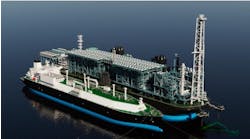Offshore staff
HOUSTON – BP officials today explained plans going forward to deal with the oil leak in the Gulf of Mexico following the explosion and sinking of Transocean’s Deepwater Horizon drilling rig.
Tony Hayward, CEO, said the company is looking into multiple, concurrent options subsea to halt the oil flow while addressing the oil on the surface and threatening the shoreline.
Within the next 72 hours, Hayward said, BP will deploy a smaller dome which the company thinks might be less prone to hydrate formation because it will capture less water than the larger dome. The large dome was installed and then removed when it became plugged with icy hydrates. This new dome, referred to as a “top hat,” will be deployed on drill pipe and will be ready to flow oil upon installation rather than facing a startup period. The startup period can contribute to hydrate formation.
At the same time, BP is examining ways to hot tap into the riser away from the wellhead, to remove the riser and add another BOP or valve, and to perform a “top kill” to plug the oil flow.
Drilling continues at 9,000 ft on the relief well, and a second relief well is scheduled to start drilling on Friday.
As for the flowing oil, Hayward said seabed and surface dispersants were providing some relief, as are controlled burns of the hydrocarbons.
Kent Wells, senior VP of Exploration and Production for BP America, said the spill was an unprecedented technical challenge because of the 5,000-ft water depths and that experts from around the world were engaged in the problem.
The first issue, Wells said, is to contain the oil flow and the second step is to control it. Expanding on Hayward’s comments, Wells said the top kill plans included using the choke and kill lines for the junk shot and then the drilling fluids necessary to control the well. Several efforts with differing plug materials will be made if necessary. When that point is reached, the well will be cemented and abandoned, he said.
05/10/2010


